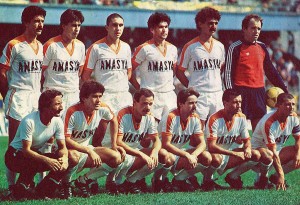First Division. 18 teams in it and still the classic point-system was in use: 2 points for a win, 1 for a tie. One outsider this year, fairly equal bulk, and 5 teams stronger than the rest. Perhaps the most important outcome of this season was negative: the decline of Izmir reached its bottom. Goztepe was already in Second Division and not coming back. Now their city rivals followed them.
 Altay (Izmir) was the outsider of championship, finishing last with 21 points. Thus, Izmir was completely out of First Division for the next year.
Altay (Izmir) was the outsider of championship, finishing last with 21 points. Thus, Izmir was completely out of First Division for the next year.
The other three relegated teams were more or less unlucky – a point or two would have placed them outside relegation zone. Gaziantepspor was 17th with 27 points.
 Samsunspor – 16th with 28 points. Standing from left: Naim Anuştekin, Kenan Topçu, Eyüp Gümüş, Adnan Öztekin, Önder Mustafaoğlu, Murat Şimşek.
Samsunspor – 16th with 28 points. Standing from left: Naim Anuştekin, Kenan Topçu, Eyüp Gümüş, Adnan Öztekin, Önder Mustafaoğlu, Murat Şimşek.
First row: Tanju Çolak, Emin Kar, Metin Karabulut, Hasan Şengün, Ahmet Usta.
Mersin Idmanyurdu SK was 15th with 29 points – taking this place and relegated only because of worse goal-difference. Mersin, however, distinguished itself this year in few aspects: first, freshly promoted teams were still prime candidates for immediate relegation – 2 of the 4 newcomers went down right away: Samsunspor and Mersin. Second, Mersin scored the least goals in the championship – only 19 in 34 games. The only club scoring less than 20 goals. Third, Mersin was relegated, but also was going to play in the European tournaments. The good, the bad, lucky, unlucky – all in one bag.
Antalyaspor survived, thanks to better goal-difference – lucky 14th. How close were the teams of the bulk of the league? Seven points was the difference between the 6th and the 17th in the final table.
 Adanaspor – 10th with 32 points.
Adanaspor – 10th with 32 points.
 Kocaelispor (Izmit) – 9th with 33 points.
Kocaelispor (Izmit) – 9th with 33 points.
 Bursaspor – 8th with 33 points.
Bursaspor – 8th with 33 points.
Ankaragücü SK was at the top of bulk of equal teams: 6th with 34 points. Most of their points came from ties – a league record 18 ties! As a whole, it was almost perfect 50% performace: 8 wins, 8 losses, 38 goals scored, 37 received. Nothing special, playing safe – and high in the final table at the end. It was performances like that triggering the point change around Europe from 2 points for a win to 3 – teams like Ankaragücü already the old system meaningless – why risking, if you could get a point in most matches. Two ties were safer bet than one win. But ties do not make champions and Ankaragücü was 5 points behind the 5th placed.
 Besiktas was 5th with 39 points. Lean and disappointing period for one of the big three of Turkish football – once again, not in the race for the title.
Besiktas was 5th with 39 points. Lean and disappointing period for one of the big three of Turkish football – once again, not in the race for the title.
Boluspor took the 4th place – a great season for them, even surprising one.
 Galatasaray finished with 44 points. Close to the top, but only that. Good only for bronze medals, which for Galatasaray counts only as a disaster.
Galatasaray finished with 44 points. Close to the top, but only that. Good only for bronze medals, which for Galatasaray counts only as a disaster.
The title was contested between Trabzonspor and Fenerbahce and was decided by tiny difference – 2 points. Fenerbahce won one game more than their rivals and that was that.
There was no question by now – Trabzonspor was firmly established as the 4th strongest Turkish club, consistently running for the title. They lost it this year, but there was nothing to be ashamed of – the team fought to the end.  Standing from left: Güngör, Tuncay, Levent, Lemi, Şenol, Necati
Standing from left: Güngör, Tuncay, Levent, Lemi, Şenol, Necati
First row:İskender, Dobi Hasan, Osman, Kemal, Turgay .
 Fenerbahce prevailed minimally, so it was even sweeter victory. Standing from left: Güngör Tekin, Yaşar Duran, Selçuk Yula, Ibrahim Begovic, Zafer Dinçer, Arif Kocabıyık, Sertaç Olcayto, Sedat Karaoğul, Hasan Özdemir, K.Hasan, Alparslan Eratlı
Fenerbahce prevailed minimally, so it was even sweeter victory. Standing from left: Güngör Tekin, Yaşar Duran, Selçuk Yula, Ibrahim Begovic, Zafer Dinçer, Arif Kocabıyık, Sertaç Olcayto, Sedat Karaoğul, Hasan Özdemir, K.Hasan, Alparslan Eratlı
Crouching: Özcan Kızıltan, Alper, Önder Çakar, Erdoğan Arıca, Müjdat Yetkiner, Can, Suat, Osman Denizci, İsmail, Metin.
18 wins, 13 ties, only 3 lost games. 43 goals scored, 20 received. 49 points. Second-best defensive record – Trabzonspor received fewer goals, 19, and third in scoring – Galatasaray (50) and Besiktas (49) outscored the champions. But where were the top scorers and where was Fenerbahce at the end?
 Adding one more trophy to their illustrious collection. Turkish football was getting stronger, yet, foreign players were few – Fenrebahce had one this season, the Yugoslav Ibrahim Begovic – not a famous player. But useful enough in this wonderful season, for Fenerbahce took it all.
Adding one more trophy to their illustrious collection. Turkish football was getting stronger, yet, foreign players were few – Fenrebahce had one this season, the Yugoslav Ibrahim Begovic – not a famous player. But useful enough in this wonderful season, for Fenerbahce took it all.




































